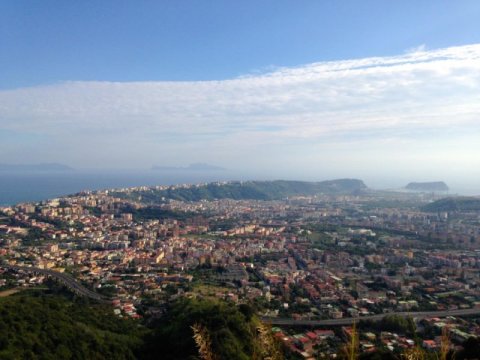[ad_1]
The caldera-forming eruption of Campi Flegrei (Italy) 40,000 years ago is the largest known eruption in Europe during the last 200,000 years, but little is known about other large eruptions at the volcano prior to a more recent caldera-forming event 15,000 years ago. A new Geology article by Paul Albert and colleagues discusses a 29,000-year-old eruption, here verified as coming from Campi Flegrei, that spread a volcanic ash layer more than 150,000 square kilometers of the Mediterranean.
Knowledge of large explosive eruptions is mostly established from geological investigations of the exposed deposits found around the source volcano, with the deposits of large eruptions forming thick sequences. However, since the late 1970s, a widespread volcanic ash layer, dated at about 29,000 years ago, was commonly identified in marine and lake sediment cores from across the Mediterranean, documenting the occurrence of a large-magnitude eruption. Despite this widespread distribution and relatively young age, no clear evidence of such an event was identified at any of the main active volcanoes in the region.
In this study, the team’s detailed chemical analysis (volcanic glass) of an eruption deposit found five kilometers northeast of Campi Flegrei caldera in Naples, Italy, are entirely consistent with the distinctive composition of this ash layer. This, combined with new dating of the near-source eruption deposit, verifies that Campi Flegrei was responsible for this widespread ash layer.
Constraints on the size of the eruption were determined by the team using a computational ash dispersal model which integrated the thicknesses of the near-source eruption deposits, named here the Masseria del Monte Tuff, with those of the related ash fall across the Mediterranean.
The results indicate that this eruption at Campi Flegrei caldera was similar in scale to the younger of two known large-magnitude, caldera-forming eruptions at the volcano, the Neapolitan Yellow Tuff (about 15,000 years ago). The Masseria del Monte Tuff eruption was smaller than the older caldera-forming eruption, the enormous Campanian Ignimbrite (about 40,000 years old), which dispersed ash as far as Russia (more than 2,500 km from the volcano).
The 29,000 year old Masseria del Monte Tuff eruption positioned between known caldera-forming events significantly reduces the recurrence interval of large magnitude events in the eruptive history of Campi Flegrei caldera.
In contrast to other large magnitude events at Campi Flegrei, the lack of thick, traceable, deposits for this eruption appear to be the result of the eruption dynamics and their destruction and burial by more recent activities. This research highlights the benefits of investigating explosive eruption records preserved as ash fall in sedimentary records when attempting to accurately reconstruct the tempo and magnitude of past activity at highly productive volcanoes such as Campi Flegrei.
Story Source:
Materials provided by Geological Society of America. Note: Content may be edited for style and length.
[ad_2]















